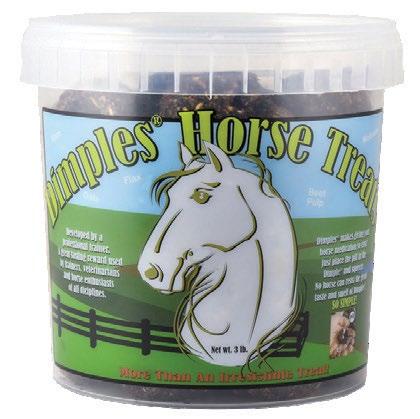





Scan this code with your phone or go to wildhorsesonline.blm.gov










Place

Pick-up
July 14-21, 2025
Animal pick-up locations include:
• Cedarburg, WI
• Cullman, AL
September 8-15, 2025
Animal pick-up locations include:
• Carthage, MO
• New Iberia, LA
November 10-17, 2025
For additional information and pick-up locations, go to: wildhorsesonline.blm.gov

President: Jennifer Sweet
Executive Director: Teresa Woods
Editor: Sarah Evers Conrad
Graphic Designer: Cindy Kassebaum
DISCOVER USPC, The Official Magazine of The United States Pony Clubs, Inc. is published two to three times a year by The United States Pony Clubs, Inc. and mailed to Pony Club members/families and Corporate Members. Readers are encouraged to submit ideas or articles for publication. Address all correspondence to the Editor at the above address. USPC is not responsible for the opinions and statements in signed articles and paid advertisements. These opinions are not necessarily the opinions of USPC and its staff. Pony Club recognizes that equestrian headgear that does not meet USPC Policy #0810 is not safe, although certain equestrian activities pictured in this magazine may not adhere to these requirements. Change of address must be made six weeks before date of publication for next issue to be delivered to a new address. Address changes can be made to your USPC member profile online or by mail. POSTMASTER: Send address changes to United States Pony Clubs, 4041 Iron Works Parkway, Lexington, KY 40511-8483.
ABOUT ADVERTISING: Pony Club does not endorse any publication, service, or product, and reserves the right to refuse any advertising not in the best interest of USPC membership. Advertising in DISCOVER USPC, The Official Magazine of The United States Pony Clubs, Inc. does not imply any such endorsement; nor does Pony Club warrant as to the accuracy of any claims made by such advertisements that claim to meet Pony Club needs or requirements. Advertising does not necessarily reflect the standards and practices of Pony Club.
PUBLICATION EDITORS, NOTE: Unless it has been cited as having been reprinted from another publication, permission to reproduce any article or other editorial content published in DISCOVER USPC, The Official Magazine of The United States Pony Clubs, Inc. must be requested from the Editor at communications@ponyclub.org and with the condition that credit is given as follows: Reprinted from (issue date) of DISCOVER USPC, The Official Magazine of The United States Pony Clubs, Inc. with permission of the United States Pony Clubs. © 2025, The United States Pony Clubs, Inc. All rights reserved. Reproduction in whole or in part without permission is prohibited. No rights for commercial use or exploitation are given or implied. DISCOVER USPC are trademarks of The United States Pony Clubs, Inc. registered in the U.S. Patent and Trademark Office.



website: ponyclub.org uspc@ponyclub.org inquiries@ponyclub.org shopponyclub@ponyclub.org marketing@ponyclub.org communications@ponyclub.org development@ponyclub.org executivedirector@ponyclub.org memberservices@ponyclub.org instruction@ponyclub.org activities@ponyclub.org testing@ponyclub.org advertising@ponyclub.org
ISSN 2767-1860 (Print) ISSN 2767-1887 (Online)







Dormosedan® Gel (detomidine hydrochloride) is the only oral, mild-standing sedative that can be prescribed by your veterinarian and given by you to help facilitate safe experiences for horses and handlers.
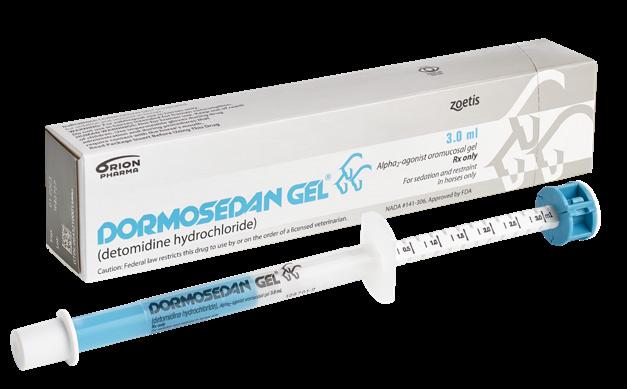

IMPORTANT SAFETY INFORMATION:
Do not use DORMOSEDAN GEL in horses with pre-existing atrioventricular (AV) or sinoatrial (SA) block, with severe coronary insufficiency, cerebrovascular disease, respiratory disease, or chronic renal failure. Do not use in anesthetized or sedated horses, or in conditions of shock, severe debilitation or stress due to extreme heat, cold, fatigue or high altitude. Do not use in horses intended for human consumption. Handle gel-dosing syringes with caution to avoid direct exposure to skin, eyes or mouth. See brief summary of prescribing information below or visit www.DormGel.com/PI.
detomidine hydrochloride)
Alpha2-agonist oromucosal gel
Rx only
For Sedation and Restraint in Horses Only
CAUTION:
Federal law restricts this drug to use by or on the order of a licensed veterinarian.
INDICATIONS:
DORMOSEDAN GEL is indicated for sedation and restraint in horses.
DOSAGE AND ADMINISTRATION:
DORMOSEDAN GEL produces sedation when administered sublingually at 0.018 mg/lb (0.040 mg/kg). DORMOSEDAN GEL must be placed beneath the tongue of the horse and is not meant to be swallowed. The dosing syringe delivers the product in 0.25 mL increments. The following dosing table may be used to determine the correct dose of DORMOSEDAN GEL (Table 1).
Table 1: Sublingual dosing of DORMOSEDAN GEL
Approximate Range of Approximate Range Dose
Use impermeable gloves when handling the product. Remove the syringe from the outer carton. While holding the plunger, turn the ring-stop on the plunger until the ring is able to slide freely up and down the plunger. Position the ring in such a way that the side nearest the barrel is at the desired volume marking. Turn the ring to secure it in place. Make sure that the horse’s mouth contains no feed. Remove the cap from the tip of the syringe and save for cap replacement. Insert the syringe tip into the horse’s mouth from the side of the mouth, placing the syringe tip beneath the tongue at the level of the commisure of the mouth. Depress the plunger until the ring-stop contacts the barrel, depositing the product beneath the tongue. Take the syringe out of the horse’s mouth, recap the syringe and return it to the outer carton for disposal. Remove gloves for disposal.
For the best results, allow adequate time (a minimum of 40 minutes) between administration of DORMOSEDAN GEL and beginning the procedure. In general, horses show sedative effects lasting approximately 90-180 minutes.
Withhold food and water until the sedative effects of the product wear off.
CONTRAINDICATIONS:
DORMOSEDAN GEL is contraindicated in horses with known hypersensitivity to detomidine.
Intravenous potentiated sulfonamides should not be used in anesthetized or sedated horses as potentially fatal dysrhythmias may occur.
Do not use DORMOSEDAN GEL in horses with pre-existing atrioventricular (AV) or sino-atrial (SA) blocks, respiratory disease, or chronic renal failure.
WARNINGS: For sublingual use in horses only. Do not use in horses intended for human consumption. HUMAN WARNINGS: Not for human use. Keep out of the reach of children. Use impermeable gloves during drug administration and during procedures that require contact with the horse’s mouth. Following sublingual administration of detomidine oromucosal gel, drug concentrations up to 0.072 mg/mL were measured at 30 minutes post dose in equine saliva, equivalent to less than one percent of the original detomidine concentration in the gel. Mean drug concentrations fall to less than 0.010 mg/mL by 2 hours after drug administration, after which a slow decline occurs for several additional hours.
DORMOSEDAN GEL can be absorbed following direct exposure to skin, eyes, or mouth, and may cause irritation. Skin and mucosal contact with the product should be avoided. Use impermeable gloves at all times.
In case of accidental eye exposure, rinse abundantly with fresh water. In case of accidental skin exposure, wash with soap and water. Remove contaminated clothing. Appropriate precautions should be taken while handling and using gel syringes. Accidental exposure could cause adverse reactions, including sedation, hypotension, and bradycardia. Seek medical attention immediately but do not drive because sedation or changes in blood pressure may occur.
Individuals with cardiovascular disease (for example, hypertension or ischemic heart disease) should take special precautions to avoid exposure to this product.
Caution should be exercised when handling sedated horses. Handling or any other sudden stimuli, including noise, may cause a defense reaction in an animal that appears to be heavily sedated.
Rare cases of human abuse of detomidine products have been reported. DORMOSEDAN GEL should be managed to prevent the risk of diversion, through such measures as restriction of access and the use of drug accountability procedures appropriate to the clinical setting.
Note to physician: This product contains an alpha2-adrenoceptor agonist.
PRECAUTIONS:
DORMOSEDAN GEL must be placed beneath the tongue of the horse. Unlike most oral veterinary products, this product is not meant to be swallowed. Swallowing could result in ineffectiveness.
DORMOSEDAN GEL does not provide analgesia. Do not use for painful procedures.
Do not use with other sedative drugs because the effects may be additive.
Repeat dosing has not been evaluated.
The use of an alpha2-agonist reversal agent with DORMOSEDAN GEL has not been evaluated.
Before initiating any procedure, allow sedation to fully develop. Nervous or excited horses with high levels of endogenous catecholamines may exhibit a reduced pharmacological response to alpha2-adrenoceptor agonists like detomidine. In agitated horses, the onset of sedative effects could be slowed, or the depth and duration of effects could be diminished or nonexistent. When the product is administered, the animal should be allowed to rest in a quiet place for a minimum of 40 minutes.
Do not use DORMOSEDAN GEL in horses with cardiovascular disease, respiratory disorders, liver or kidney diseases, or in conditions of shock, severe debilitation, or stress due to extreme heat, cold, fatigue, or high altitude. Protect treated horses from temperature extremes. As with all alpha2-adrenoceptor agonists, the potential for isolated cases of hypersensitivity, including paradoxical response (excitation), exists.
DORMOSEDAN GEL has not been evaluated in ponies, miniature horses, or horses younger than one year of age.
DORMOSEDAN GEL has not been evaluated for use in breeding, pregnant, or lactating horses.
ADVERSE REACTIONS:
Clinical field study:
In a
In a laboratory study, transient erythema of the mucous membranes was seen in 2 (of 8) horses that received the recommended dose of detomidine gel.
Mild ataxia (horse stable but swaying slightly) was observed in 54% of DORMOSEDAN GELtreated horses and in 4% of the placebo-treated horses at 40 minutes post treatment administration. Moderate ataxia was observed in 25% of DORMOSEDAN GEL-treated horses (0% placebo) at 40 minutes post treatment. Moderate to marked ataxia continued to 90 minutes for 5% and to 120 minutes for 4% of DORMOSEDAN GEL-treated horses.
CONTACT INFORMATION:
For a copy of the Safety Data Sheet or to report adverse reactions, call Zoetis Inc. at 1-888-963-8471. For additional information about adverse drug experience reporting for animal drugs, contact FDA at 1-888-FDA-VETS or www.fda.gov/reportanimalae.
STORAGE INFORMATION:
Store at controlled room temperature 20-25°C (68-77°F), with excursions permitted to 15-30°C (59-86°F), in the original package.
HOW SUPPLIED:
3.0 mL graduated oral dosing syringe, 7.6 mg/mL detomidine hydrochloride.
DORMOSEDAN® is a trademark of Orion Corporation.
Approved by FDA under NADA # 141-306


The United States Pony Clubs (USPC or Pony Club) is embarking on an exciting journey to reaffirm its leadership in horse care, safety, and equestrian education. In partnership with Burcham Solutions, our trusted consulting firm, we are taking a fresh look at where we stand today, identifying opportunities for growth, and ensuring our mission, vision, and strategies continue to meet the evolving needs of the communities we serve.
This strategic planning initiative is organized into several key phases, beginning with “Discover.” In this initial phase, we’re diving deep into what USPC does best and identifying areas where we can improve. It’s a time for open dialogue, thoughtful evaluation, and meaningful engagement with our members and stakeholders. A comprehensive competitive analysis is also underway to better understand our position in the equine world and uncover ways to distinguish ourselves.
Following “Discover,” we’ll enter the next phase: envisioning a bold, inspiring future for USPC—one that unites and excites our entire community.
The final phase will bring all our insights together in a three-year strategic plan, which will be reviewed and approved by the Board and then brought to life by USPC leadership.
This process is more than just planning—it’s a celebration of what makes USPC truly special. It’s a powerful opportunity to strengthen our mission of enriching lives and communities through exceptional equine education. Together, we are building a future that will have a lasting impact for generations to come.
Teresa and I look forward to sharing more as this journey unfolds.








American Saddlebreds can make great Pony Club mounts—just ask Pony Club member Zsa Zsa Beauchene. Fourteenyear-old Zsa Zsa is a member of Tennessee Valley II Pony Club in the Midsouth Region who has earned her C-2 HM, D-3 EV, and D-2 DR. In 2024, she and her horse, Knight Skye’s Storm Chaser (aka, Chase), a HalfSaddlebred/Half-Friesian registered with the American Saddlebred Horse Breeders Association (ASHBA), earned a special recognition award for Pony Club members who participate on an ASHBA-registered horse in Pony Club activities through the ASHBA/USPC Awards Program.
While American Saddlebreds are wellknown for their elegant appearance and brilliant presence in the saddle seat show ring, they can also excel as sport horses, including jumping, dressage, eventing, combined driving, and more.
“Saddlebreds can do anything...and look darn classy doing it,” is a favorite quote that Zsa Zsa shared from the American Saddlebred Museum.
“It is very true regarding the whole of the breed, but especially true when it comes to my horse Chase,” says Zsa Zsa. “It means so much to me that Chase has been recognized as the horse that he is.”
Knight Skye’s Storm Chaser is often said to be a jack of all trades, according to Zsa Zsa. Chase has done many different disciplines over his 19 years, including combined driving, foxhunting, show jumping, and trail riding. Zsa Zsa says Chase seems to enjoy adventure, new things, and traveling. He has been ridden/ driven in at least 15 different states.
Zsa Zsa’s late mother bought the Kentucky-born horse as a weanling to try in combined driving in pairs and in four-in-hand. However, they realized that all Chase wanted to do was stare at the obstacles rather than go through them. So, he began honorarily whipping in with the Tennessee Valley Hunt. C hase quickly learned that when the huntsman told you to go somewhere, you went…and fast. “If ever a gate was in the way, he would just jump it,” she says.

Zsa Zsa began riding him in 2022, and they are currently focused on foxhunting. “Chase is smart and clever, sometimes aggravatingly so,” she says. “He is also very handsome, and he knows it! I have truly realized how awesome a horse I have.”
She calls him a joy to ride. “If you can create a bond with a Saddlebred, they would jump the moon for you,” she adds. “Since we began Pony Club, many new doors have opened up for us, and we couldn’t be more grateful.”
The American Saddlebred Horse & Breeders Association (ASHBA) sponsors the ASHBA/USPC Awards Program for Pony Club members who participate in Pony Club activities on their registered American Saddlebred or Half-Saddlebred Horse. Pony Club members can earn points by riding in lessons, clinics, and preps, or by competing in regional and/or national rallies or achieving a regional or national certification level. Learn more and join the program if you ride a horse registered with ASHBA at www.ponyclub. org/activities/programs

—USPC Staff, with Zsa Zsa Beauchene
Arecent air show staffed by volunteers I attended reminded me of the dedicated volunteers of USPC. From parents cooking at Pony Club camps to those in leadership positions, volunteers are the backbone of our organization. USPC simply could not exist without them. They are, and always will be, an essential part of Pony Club.
The nature of volunteerism is changing, with shifts in participation rates, motivations, and styles of engagement. While traditional, long-term volunteering has seen a decline, new forms have emerged. Factors like the ones below have all shaped this evolving landscape.
■ Formal volunteer participation declined between 2019 and 2021
■ Volunteer rates historically increase during times of crisis, such as wars, epidemics, and natural disasters
Participation among those aged 65+
and active social networks.
■ Teenagers are volunteering more, often driven by school and college admissions requirements.
■ Many volunteers now prefer shortterm, flexible roles motivated by personal benefit and growth.
■ Technology allows individuals to contribute expertise remotely and on their own schedule.
■ Short, focused tasks appeal to those with limited time.
■ More companies now support employee volunteerism through programs and matching grants.
■ Volunteerism continues to respond to evolving needs like climate change, migration, and humanitarian efforts Online platforms and virtual volunteering are now widespread.


■ Organizations must offer flexible opportunities to attract younger generations and busy professionals.
■ Volunteering helps build social capital, strengthen communities, and foster cohesion.
The volunteering landscape is dynamic and constantly evolving, but its purpose remains the same: connecting individuals with opportunities to make a difference.
As we plan for the future, we must take this evolution of volunteerism into account in our strategy and outreach. We will continue to evolve and ensure USPC thrives for future generations.
—Jennifer Sweet, USPC President, Written for the June 2025 Board Report
For those interested in volunteering in Pony Club, turn to page 12 to learn more. If you want to volunteer nationally, please email activities@ponyclub.org.

Sometimes team sports involve both 2-legged and 4-legged athletes. The Interscholastic Equestrian Association (IEA) has student athletes in grades 4-12 who ride Hunt Seat, Dressage and Western in a draw-based (catch-ride) format. Over 15,000 members on 1,500+ teams across the United States. Give your student rider a leg up into collegiate riding without having to own a horse.
Membership for the 2025-2026 Season opens in June. The IEA season runs August 2025 to May 2026. Join a team or start a new team in your area today!

It’s easy to forget about routine safety in the comfort of our own barn or around a horse that we know well and trust.
Here are some reminders from the Safety in the Barn course on Allpony.com (www.allpony.com/courses/swafety-in-the-barn).
Tie Safely: Always tie with a quick-release knot that can be untied quickly in case of an emergency. To keep a horse from getting tangled, don’t leave too much slack in the lead rope—about 18 inches is a good rule of thumb. Cross-ties should have safety release snaps that will open if a horse panics and pulls back.
Don’t Get Tangled: When leading a horse, always fold the excess lead rope or rein in your hand so that it doesn’t drag on the ground or get stepped on by the horse. Never loop, wrap, or attach a lead rope or reins around your hand, wrist, or any body part!
Keep Floors and Walkways Clear: Put items away instead of leaving them in the cross-ties, wash racks, aisles, etc.
Hang Hay Nets and Water Buckets at a Safe Height: Hay nets and water buckets should be hung at around a horse’s

shoulder height or higher so the horse doesn’t get a hoof caught. Sign up for Allpony.com to take the Safety in the Barn course. There are many more safety tips in the full course. Test yourself with quizzes and games. Pony Club members receive a special discount, available at www.ponyclub.org/pony-club-perks.


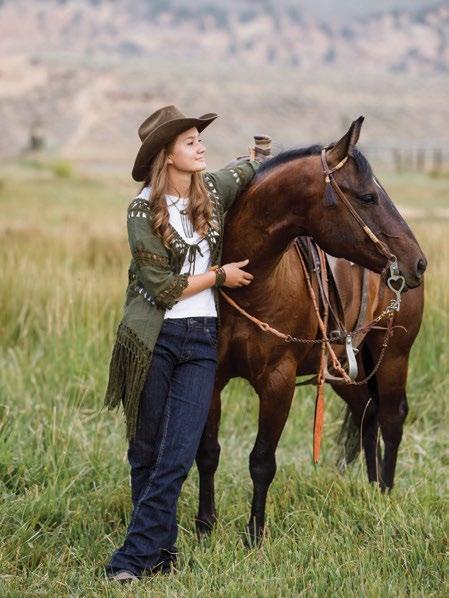

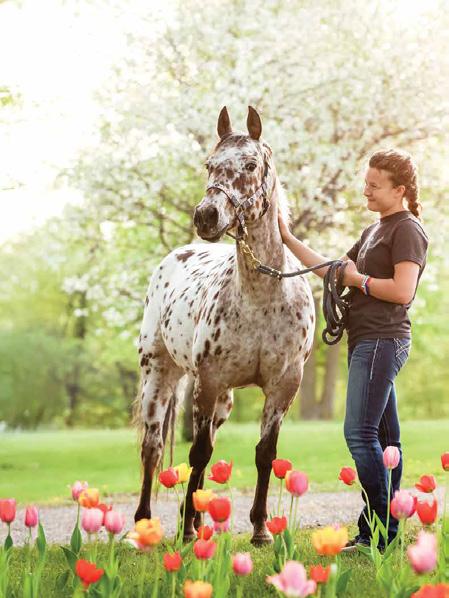






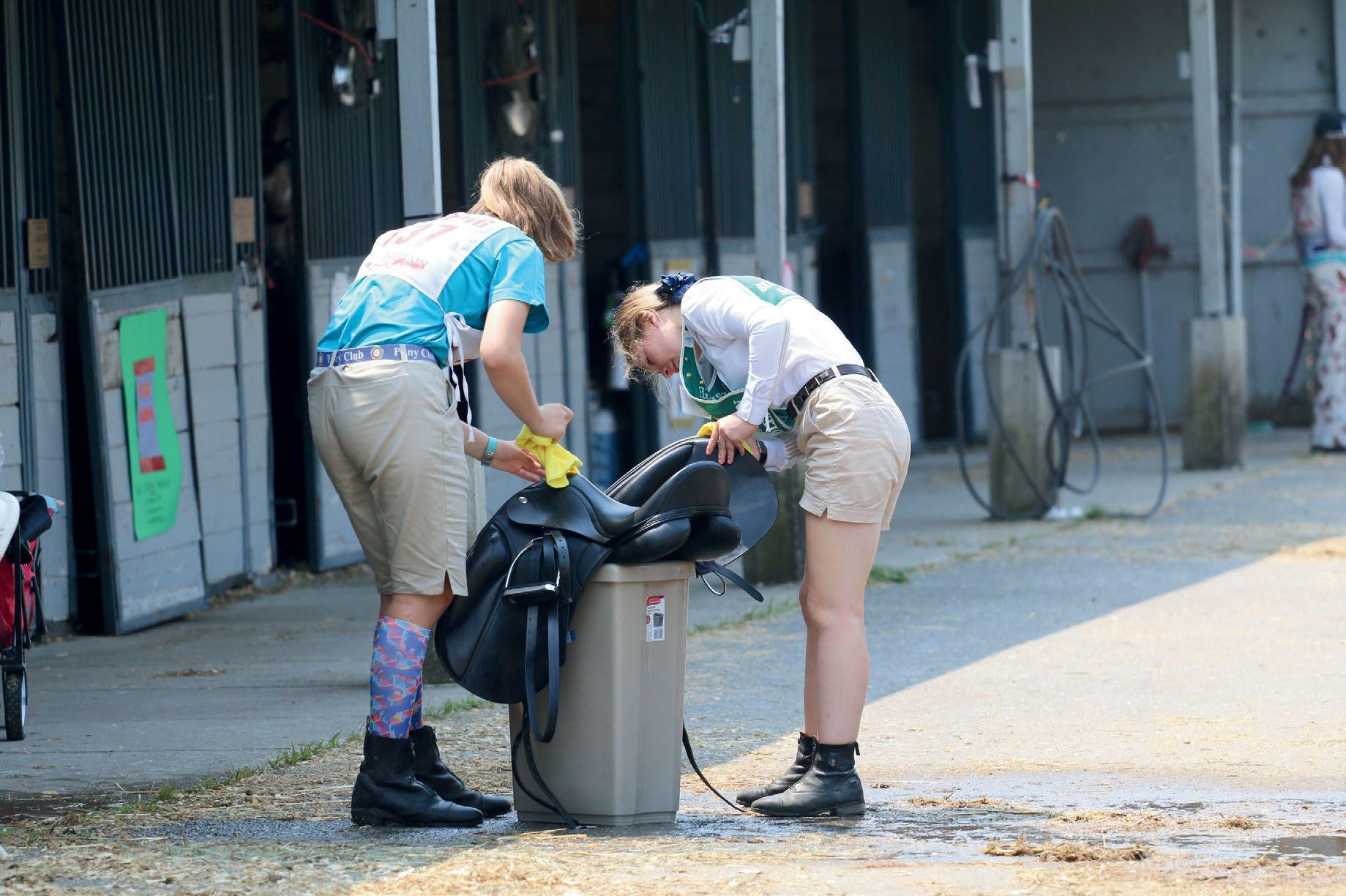



AGE: 19 CLUB/REGION:
YEARS IN PONY CLUB: 12

Current certification:
H-B Horse Management, B Eventing, C-2 Dressage
What disciplines and/or activities are you involved in?
Eventing, Dressage, and Foxhunting
How did you get started with horses? Are you a member of any other equine organizations?
Both my parents were involved in horses. That is how they met! My mom was in Pony Club when she was younger. Horses have always been a big part of my life, and that part of my life has only grown since I joined Pony Club! I am a member of the United States Dressage Federation (USDF), the United States Eventing Association (USEA), and the United States Equestrian Federation (USEF).
Tell us about your current mount(s) and what you do with them: Her name is Annie, and she is a homebred Irish Sport Horse. We have competed together for about five years, and as we grow, we learn from each other. We have competed at the FEI 2* level and have plans to continue at this level and possibly higher!

Tell us about your goals (with Pony Club, with riding, and life):
Some goals have already been achieved this year. I was selected to be a part of the USPC team in the Pony Club International Alliance (PCIA) Inter-Pacific Exchange team in Australia this fall, which was a big goal for me as I want to follow in my mom’s footsteps. She did this same exchange in 1995 in Japan. I am so grateful to have gotten this opportunity and will continue to work hard! I will hopefully be earning my USDF Silver medal with my other horse Demi, as well as taking certification tests for my A in Eventing and in Dressage. Lots of goals have been set this year, and I will be working hard to make them reality!

Amira once dressed up as the jockey of Triple Crown winner American Pharoah for a Mounted Games rally.
What is one thing you would tell younger members about joining the United States Pony Clubs?
Get ready for the ride of your life! This is the best place to be if you want to learn anything and everything about horses!
What is your favorite thing about Pony Club?
My favorite thing is Horse Management. It is such a big part of the horse world and definitely the most important. It is amazing to have the opportunity to learn a universal way to take care of horses to ensure they are healthy and happy.
What is your favorite way to prepare for a Horse Management certification?
Reading and re-reading the Standards of Proficiency and test sheets and working through your answers in different scenarios. You never know how the Examiner will word a hidden question!

If you could try out any other discipline or activity, what would it be and why?
I would love to learn more about the rules of Show Jumping—it is a fascinating, fastpaced sport, and I would love to participate in shows.
Describe your favorite Pony Club memory:
The Mounted Games rally in 2015. I dressed up as the jockey of Triple Crown winner American Pharoah for our Halloween costume parade. My grandmother had material for the silks he wore, and I borrowed my uncle’s racing pants. We even made the helmet cover out of duct tape!
What is your favorite part about Pony Club?
As of right now, there are many opportunities I get to experience as an upper-level member, such as international exchanges, National Youth Congress, the National Youth Board, and the opportunity to meet so many professionals that have graduated from Pony Club!
Have you done any specific special activities in Pony Club, such as International Exchanges, Recognition Programs, virtual competitions, etc.?
I recently attended the 2025 USPC Convention as a member of the National Youth Congress, where we created a proposal to give to the Board of Governors regarding a change we would like to be made in Pony Club to add more animal welfare policies. I also recently got accepted to be a part of the Inter-Pacific Exchange team, which I am so very grateful for! I look forward to meeting my wonderful teammates.
What makes you #PonyClubProud?
Being involved in such an amazing worldwide organization that promotes horse health and knowledge makes me Pony Club proud!



• Replenishes the
• Stimulates the thirst response to keep horses drinking.
• Supports quick recovery after exercise.

By Sarah Evers Conrad, USPC Marketing and Communications Director
Volunteers are the heart of the United States Pony Clubs (USPC). After all, volunteerism is one of the core tenets taught by the program. They are the behind-the-scenes force that keeps our clubs and centers thriving, our events successful, and our members safe and supported. Our volunteer ranks—which number more than an impressive 25,000 volunteers—are filled with parents, grandparents, aunts/uncles and other family members, friends, and current and former members. In addition, for those who love horses and want to give back, USPC clubs/centers and regions should be a welcoming place to volunteer, although some requirements, such as background checks and SafeSport training, should be in place beforehand.
Volunteering is a fulfilling way to connect with others, learn new skills—including leadership—and it strengthens the entire Pony Club community. Let’s take a closer look at why volunteering is so important and explore the many ways you can get involved.
Since its inception in 1954, Pony Club volunteers have always played a vital role. Volunteers ensure that meetings, rallies, clinics, and certifications run smoothly. They help provide safe, educational, and fun experiences for members from the local to the national level. They educate Pony Club audiences, help plan events, set up dressage and jump rings, assist with Horse Management, help at meetings and clinics, and much more.
But volunteerism isn’t just about helping Pony Club run well—it’s also about fostering lifelong friendships and learning opportunities for members of all ages. Parents who volunteer often discover they enjoy the experience as much as their children do. Grandparents find that they can share in the excitement and pass along their wisdom to multiple generations. Alumni find ways to stay connected. And current members put into practice the values that the Pony Club program teaches.
Sedate Kohler, who earned her H-A HM and C-2 EV certificiations when she was a member of Racine County Pony Club and is a teacher in her day job, says she was “bit by the volunteering bug early on” when she was on a youth board. She’s done everything from organizing clinics for her club, being a Horse Management Organizer (HMO) for her region, to serving on the National Youth Board. Currently, she serves as a Board Member and as the coordinator for Pony Paddock at USPC Conventions.
“I loved being the one that people could rely on to answer questions and be ground support for various activities,” she says. “I’ve gained priceless experience during my time in various volunteer roles—often aspects I can utilize in my professional life.”
Local clubs and riding centers are always in need of dedicated volunteers. Here are some of the many roles you might consider:
■ Club Officers and Center Volunteers: Club officer roles—District Commissioner (DC), Joint DC, Secretary, and Treasurer—are essential in guiding activities at the club level. At Pony Club Riding Centers, Center Administrators (CAs) and Assistant Center Administrators (ACAs) take on many responsibilities to have Pony Club programming at their facility, and they also

rely on volunteers to do things, such as ensure meetings, lessons, and local certifications are organized and that members and their families enjoy their time in Pony Club.
■ Event Support: From setting up show jumps to scoring an event or running the show office, there are endless tasks to help with at club events and rallies. If you enjoy being outside and active, this is a great way to pitch in!
■ Horse Management Judges: If you have a passion for safety and horsemanship, consider becoming an Assistant Horse Management Judge (AHJM). Horse Management judges help ensure that rallies and events meet USPC’s standards for safety, horse care, and stable management. You’ll work with competitors, encourage safe horsemanship, and help foster an educational atmosphere. Learn more at www.bit.ly/uspc-rolechief-horse-management-judge
“Horse Management is the heart and soul of this organization,” says Kohler. “Being a member of an HM team, you are 100% there to be a positive ambassador of Pony Club and give your time to educate and help our members shine. It epitomizes what we are for.”
■ Volunteer as an Instructor or Clinician: If you are a knowledgeable riding instructor, clinician, trainer, or an alum of Pony Club, there are a plethora of opportunities for you to share your skills with members in your area, or even travel a bit as a clinician. Sometimes this can turn into a paying opportunity, but many donate their skills or time to clubs/centers or regions once or even several times per year.

ABOVE: “Announcing has to be my favorite thing to do since it gives me an opportunity to see the Pony Club members in action, and to a certain extent, help the competition run smoothly,” said past USPC Board Member Ray Ingandela.

At the regional level, there are more opportunities to get involved.
Regional officers are key to the success of USPC’s 40 regions. These include the Regional Supervisor (RS), Vice Regional Supervisor (VRS), Region Secretary, and Region Treasurer. Region officers coordinate with clubs and centers, helping to organize regional or multi-region rallies, certifications, and clinics. It’s a chance to support multiple clubs/centers and to make a big impact, and it’s one of the biggest ways to be involved.
The Regional Instructional Coordinator (RIC) provides support to clubs and centers in their region by helping to develop instructional programming and offering advice and education to new clubs and centers concerning local-level testing and how to find an Examiner. It’s an important role so that members have access to quality education and resources. In addition, they oversee the region’s national testing calendar, along with the RS, and provide
supporting programs for candidates wishing to take a certification test.
Horse Management Organizers coordinate and train various Horse Management judges for rallies and ensure that the competitions meet Pony Club’s high standards. They also coordinate Horse Management instruction in the region and for certification preps. This role is key in helping members develop the skills they learn in Pony Club.
RICs and HMOs are elected by the Regional Council, so you would need to reach out to your region’s nominating committee to let them know of your interest.
Rallies and horse shows provide an educational and competitive opportunity for Pony Club members to put all they’ve learned into action, but they simply couldn’t happen without volunteers. Here are a few of the many ways you can help:
■ Steward
■ Scorekeeper/Timer
■ Operations/Equipment Crew
■ Score Runners
■ Announcer
■ Rally Organizer or Assistant, Show Secretary, and Office Staff
■ Hospitality
■ Horse Management Barn Helpers
■ Fence Judge (if cross-country is included)
■ Scribe
No matter what your skills or interests are, there’s a volunteer role that can fit your schedule and abilities. Many volunteers find that starting small—like helping set jumps at a rally or bringing snacks for a meeting— quickly turns into a love for volunteering that grows with each new experience.
Past Board Member Ray Ingandela, who first found Pony Club as a parent, originally started volunteering as a way to stay busy when his daughter was competing. He’s done everything from various officer positions as a DC and Joint DC, Region Mounted Games Chair and coordinator, announcing at rallies and at USPC Championships, and emceeing at the USPC Convention, as well as serving on the Board of Governors. It went from just wanting to keep busy to becoming friends

Volunteering at the Kentucky Three-Day Event is a big deal for many Pony Club members and alumni, especially those from the local Midsouth Region. Volunteers serve in a variety of roles, including running scores during the dressage phase.
with regular volunteers and then “becoming family,” he says.
“Pony Club created a whole new social group for me and my wife,” adds Ingandela. “At its core, Pony Club is a wholesome and worthwhile entity that deserves my support. It helped shape my daughter into the successful woman she is today.”
For those who want to be part of the action on a grander scale, volunteering at USPC’s national events—USPC Festival and USPC Convention—can be a truly rewarding experience.
■ USPC Festival: Volunteers at Festival help with everything from setting up competition arenas to assisting with clinics and awards. It’s an unforgettable way to experience the excitement of Pony Club at its peak.
■ USPC Convention: Volunteers assist with everything from registration, presenting, creating centerpieces for the banquet, finding sponsors, manning the silent auction, and much more. It’s also a great opportunity to connect with other volunteers and leaders from around the country, and many volunteers come yearly.
“If you have an opinion about how something went or should go next time, get involved and share it!” adds Kohler.
“Pony Club is all about actionable change, and we love passionate people who want to do the work to bring more opportunities to our members.”
If you’re ready to jump in and make a difference, reach out to a local club or center through our Find a Club/ Center page online (www.ponyclub.org/ about/find-a-club-center), or if you’re already familiar with Pony Club and ready for a bigger role, reach out to your region or to the Activities Department at activities@ponyclub.org. You can also learn more at www.ponyclub.org/ volunteer.
If there isn’t a club/center in your area, the ultimate volunteer role would be to start one. Reach out to Member Services at memberservices@ponyclub. org for more information or visit www. ponyclub.org/lead/start-a-club.
And don’t worry about not knowing what to do when you get started. The Pony Club National Office provides an abundance of volunteer training materials and leadership training, including more formal training at the USPC Convention
or through online materials. In addition, current and former leaders are always willing to help someone new.
And for those current leaders who meet new potential volunteers, remember what it was like when you started. You are a key mentor and ambassador for Pony Club. For the success of Pony Club, it’s important volunteers feel welcome, get the training they need, and enjoy their time with us…regardless of whether they serve as a one-time volunteer or for a long time. Many volunteers stay with us well beyond their family’s membership in Pony Club, and it’s always interesting to meet someone who has been volunteering for decades.
Pony Club has always been about more than riding and ribbons—it’s about safety, education, FUN…and community. When you volunteer, you become a vital part of the Pony Club family. You help teach responsibility, leadership, and teamwork while creating memories and connections that will last a lifetime. We offer a big thank you to all of our volunteers for being the heart of Pony Club!




It’s important for our horse’s welfare to develop a simple evacuation and a shelter-in-place plan in case of disaster.
By Rebecca Gimenez Husted, PhD

Disaster can strike at any time. It’s important to have plans in place to deal with various scenarios, like fire, flooding, and storms common to your local area.

Disaster scenarios occur all over the world in every imaginable place and situation—and they occur daily depending upon location, climate, geography, and hazards. Our news feeds are filled with them. You can find yourself in unnecessary danger if you are unprepared or stay in the path of an oncoming storm or disaster. Some scenarios—earthquakes, volcanic eruptions, and tornadoes—cannot be easily predicted. However, in many situations, timely evacuation or effective sheltering in place can save the lives of both animals and people. Research has shown that a lack of planning can lead to poor results for animals, as well as people.
With that said, it is possible to save lives simply by taking the time to plan, invest in a few simple logistics, and then share and practice the plan with your family, neighbors, and friends. Performing a practice evacuation and thinking through various possible scenarios can help you gain control in the chaos. For the welfare of our horses, we have an ethical, moral, and a legal responsibility in the case of a disaster that affects our area, and planning ahead gives you the chance to decide what is best for you and your horse.
Planning for various hazardous situations is most effective before the actual disaster occurs. Developing a disaster plan makes dealing with the situation smoother, less stressful, and leads to faster recovery, better outcomes, and healthier animals. Typically, people in emotionally charged situations have poor decisionmaking skills and are easily overwhelmed.
It’s important to know that most communities do not have the resources and personnel to save animals in the first minutes, hours, or even days after a major disaster. Therefore, it is crucial for animal owners and especially those who own, work with, or care for horses, to develop their own plans to protect their valuable animals and facilities.
Resilient owners actually have two plans—one for evacuation during various scenarios, such as wildfire, flooding, or a hurricane, and another for sheltering in place when you can’t evacuate, such as during a blizzard, pandemic, or a tornado, etc.
You’ll want to plan for various scenarios for each situation. For instance, it may seem simple to just move a few horses from your barn to the fairgrounds.

Ensure that your truck and trailer are in good working order at all times and that all horses know how to load quickly in case an evacuation is needed.
However, that assumption could get you in trouble. For instance, the local environment will NOT be normal once water is flowing or flames are moving, traffic is backed up and snarled on roadways, or the wind changes direction. Every step in your plan will always take longer than you think. Sometimes, the more obvious questions hit home, such as:
■ Do you own a horse trailer?
■ Do you know how to hitch it by yourself?
■ Are the tires inflated, and does the trailer have working lights and brakes?


■ Is your towing vehicle in good working order?
■ Is your trailer always accessible?
■ Are your horses trained to load quickly and easily?
The real heroes in every disaster always go unmentioned. These are the folks that you never hear about or see in the news, because they loaded up their charges and got out of the looming disaster zone before the hurricane or wildfire hit.
Get a timer and actually time a practice run for your evacuation plan. How long does it actually take you to hitch up your trailer and load all the horses? If you treat this practice as reality, as though everything you want to save—kids, horses, pets, horse registrations, paperwork, your grandma’s ashes, your wedding photos, etc.—had to be on that trailer to make it out of the disaster zone, it may change your plan, and what is on the list, for your evacuation. In many recent disasters, there has been nothing left for people to come home to, so assume the worst. What would you take? Make your list now and have it readily accessible.
During a disaster, you will need to heed any warnings from officials while paying close attention to news and weather forecasts. Ensure you have the apps on your phone and bookmark any necessary websites to get the best information for your locality (fire, flood, air quality, wind, etc.). In general, the earlier you evacuate, the less chaos and the less stress it will be for you and for your animals due to a hasty departure.

In the event it becomes unsafe to shelter in place or remain at your homestead or barn, don’t be the person that waits too late to leave. For an efficient evacuation, plan ahead and also review past incidents in your area. Have research on hand for possible boarding areas far enough away to be out of danger, and make prior contact with that place in the event you need to evacuate. Establish a relationship with them and think about a reciprocal agreement. Research veterinarians in your area, in case yours isn’t available, and also supply stores, especially ones that carry your feed brand.
Think about what can go wrong. In a disaster, things change rapidly. We can all remember the COVID-19 pandemic and how interactions and business practices across the globe changed literally overnight. COVID-19 involved a shelter-in-place disaster. Certain types of disasters cannot be evacuated ahead of time—volcanic eruptions, tornadoes, and earthquakes—or evacuation doesn’t make sense, such as during blizzards or an electrical failure. In those cases, a shelter-in-place disaster plan should be enacted, and humans should take priority for care and protection. During disasters, it can be difficult to find everyday resources, such as feed, hay, water, fuel, vet supplies, and veterinary care. Remember the toilet paper crisis during COVID? You’ll need to ensure your horses have anything needed for their care, or develop a plan to share with neighbors and they with you.

Don’t be caught off guard in case of fire, and do not wait until it’s too late to evacuate. Evacuating horses takes time.
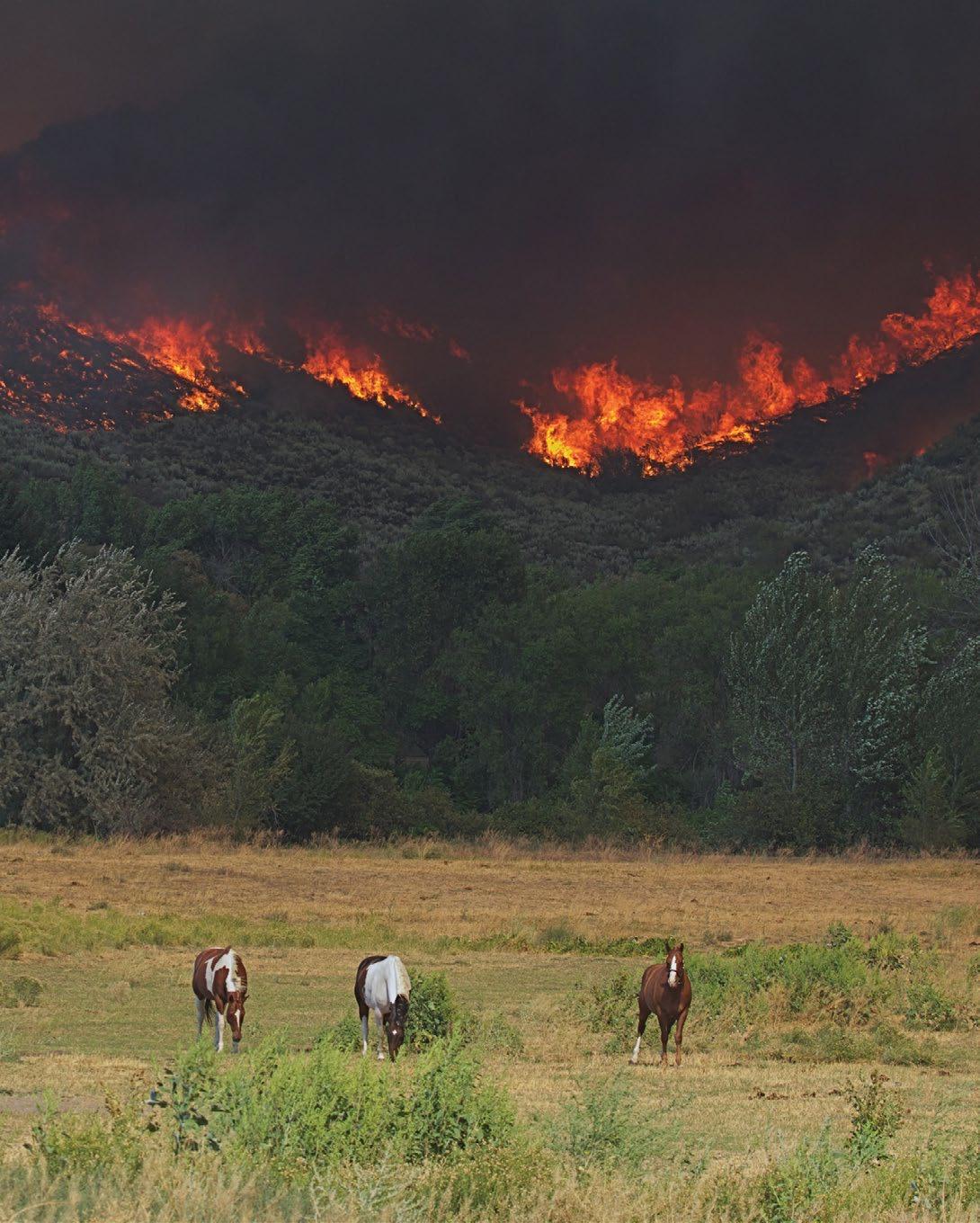


• An Unparalleled Educational Program.
• The Largest Horse-Related Trade Show in North America.
• The “Marketplace” featuring quality consignments for horse & rider.
• The Fantasia (sponsored by Myhre Equine Clinic) — Equine Affaire’s signature musical celebration of the horse on Thursday, Friday and Saturday nights.
• Breed Pavilion, Horse & Farm Exhibits, Horses for Sale and Demonstrations — Enjoy meeting horses of all shapes, sizes, breeds, colors, and disciplines!
• Equine Fundamentals Forum — Educational presentations, exhibits, and activities for new riders and horse owners, young & old.
• The Versatile Horse & Rider Competition (sponsored by Chewy) — A fast-paced timed and judged race through an obstacle course with $5,500 at stake!
• Breed Bonanza (sponsored by Sentinel by Kent and Blue Seal) — A unique under saddle class showcasing the best features of horses of all breeds.
• Adoption Affaire — Find and adopt your next horse at the Adoption Affaire.
• Youth Activities and much, much more!
For all you need to know, consult equineaffaire.com or call (740) 845-0085.



Here are some things to think about when developing your plan.
■ Research for regional and local information. You’ll want to find planned evacuation routes, commonly closed roads, sheltering locations designated by emergency management personnel, etc., and have paper maps of your area in your trailer
■ Ask your local emergency management office about their plans. State, federal, and other organizations are there to assist you, but you have to ask them to do their part to prepare for animals. Otherwise, they usually are only concerned about people.
■ Develop a detailed checklist of exactly what to do to close up your property when you leave.
■ Create an individual profile sheet for each animal or an evacuation sheet. This is especially helpful in case you end up not being the one who evacuates them.
■ Create evacuation kits and first-aid kits for humans and animals and have them ready to go. Get recommendations from an experienced veterinarian to build a kit, including any possible medications that would need to be prescribed, for use in emergency and disaster scenarios.
■ Practice trailer loading and plan the priority of animals and procedures for unloading at your designated shelter. Who goes with whom, and who goes first or last if you must make two trips?
■ Develop a reunion plan for family and animals. Where do you meet if there is a lack of communication on cell phones and someone gets lost or left behind? What are your alternate ways to communicate, such as radios, apps, leaving physical notes, etc.



■ Does your fire or emergency management department have a plan for horses? Examples would include what they would do in case you aren’t home when a wildfire threatens, etc. Do they know how to assist your horses or who they can call to pick up your animals? Where do they evacuate them to if they are evacuating animals? How do they identify them so that you can prove ownership? Do your horses have a form of identification, like a freeze brand, lip tattoo, or microchip?
■ Ensure you have extra copies of insurance, registration, wills, power of attorney, Coggins tests, health certificates, proof of ownership, and other relevant documents for animal care and identification. You can also have all copies on a digital drive.


■ In addition, evaluate your horse property on the following websites for flooding risks to determine the chance of flooding and when would you need to consider evacuating. These sites are also useful when purchasing horse properties:
■ Assess Coastal Area Risk: https://coast.noaa.gov/ stormwater-floods/assess/
■ Water Dashboard: www.usgs.gov/mission-areas/waterresources/science/usgs-flood-information
■ Flood Mapping Tools: www.fema.gov/flood-maps
■ Lastly, consider your recovery plan. Will you send someone ahead to evaluate any affected property before bringing animals home after a disaster? This is usually recommended. Is it safe from fallen/sharp objects, downed power lines, downed fences, destroyed buildings, gas leaks, or contaminated water? Recovery may take hard physical labor, time, and resources, including the need to hire heavy equipment to clear large objects or fallen trees and to rebuild fences. You don’t want to come home with horses and leave them tied to the horse trailer while you do these chores for a couple days. Preparation has been shown to be the key to survival and recovery in many animal emergencies and disasters, both large scale and small. Decide your plan ahead of time; communicate your plan to others, including your local jurisdiction emergency management director; practice to see if it works for you; and write out your checklist for both evacuation and for shelter in place. That way, all you need to do is an annual review of your plan. After all, while life has a way of throwing curve balls, we can plan ahead to keep ourselves and our horses as safe, happy, and healthy as possible.


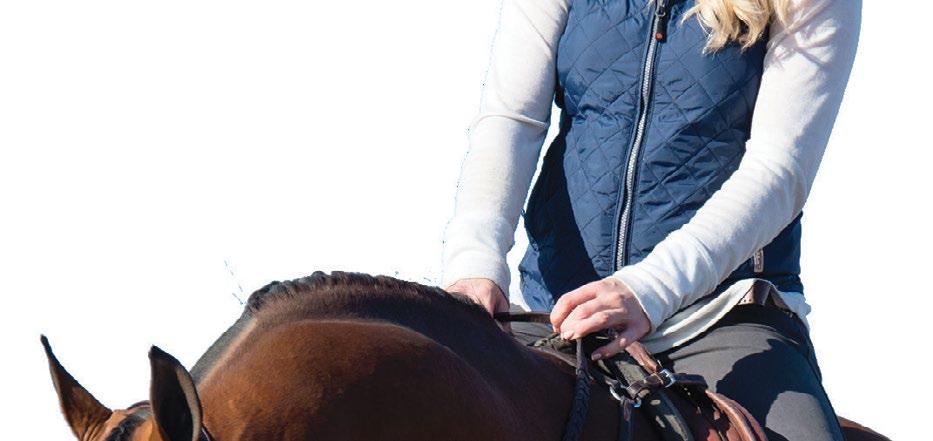


It’s the view that equestrians love…the one between the ears of our horse, especially if it’s a beautiful day with a trail spread out for miles ahead of us. Trail riding is an enjoyable pursuit, but there are safety considerations to keep in mind before, during, and after any trail ride. With proper planning, these 10 tips can help ensure your trail rides are safe and happy ones.
1. Plan, prepare, and then pack. A successful and safe trail ride begins long before your boots are in the stirrups. Start with the who, what, when, why, where, and how of it all.
■ Who is going with you? It’s safer to go with a buddy (or several). Has everyone been on a trail ride before? Is there an experienced rider, or two, in the group? For dog lovers, it’s safest to leave your canine buddy at home, unless he’s trained to stay with the group.
■ What gear and equipment do you need? What horse will you ride? What kind of fitness and experience level is needed for this particular ride for both horse and rider?
■ When are you leaving, and when should you be back? Don’t run out of daylight. Depending on the time of year, it may be best not to go out on certain trails if it’s hunting season in your area.
■ Why are you going? Do you have any particular riding goals, or is the ride just for fun? Research the local trail rules and regulations for where you are riding.
■ Where are you going? Is it safe? Don’t forget to tell someone where you are going, or you could even let them track your phone (if there is service).
■ How will you prepare and communicate in emergencies? What if there is no cell service or your cell battery dies?

2. Ensure you and your horse are ready for a trail ride. Choose an appropriate horse that is fit and trained. Introduce your horse beforehand to things he might see on the trail, such as bikes, dogs, wildlife, etc. Practice obstacles—logs and water crossings—in a controlled environment at home first.
3. Ask permission before riding on private land. Plan your route in advance and familiarize yourself with trail conditions. Respect private property so that landowners remain open to equestrians by getting permission to be on their land. Never trespass, litter, trample crops or gardens, or leave damage or messes behind. If you have to go through a closed gate, leave it just as it was before you touched it. Always thank the landowner for the ability to ride on their property.
4. Dress the part.
Always wear a certified, properly fitted riding helmet, boots with a heel, and riding pants or jeans that can protect your legs from the elements. Depending on the season, gloves can protect your hands and be breathable or provide warmth. Layered clothing is important for variable weather, and bright, reflective colors make you visible to others. Look for moisture-wicking base layers, light jackets or vests for warmth, and a waterproof outer layer if there is a chance of rain. A safety vest provides extra protection in case of a fall. Avoid wearing anything loose or dangling that could snag on a tree.
5. Pack your gear.
Consider packing the following in your trail bag: Basic first-aid items for horse and rider

■ Water and snacks
■ Sunscreen
■ Bug spray for you/fly spray for your horse
■ Extra halter and lead rope
6. Do a pre-ride check. Ensure your horse has safe, properly fitting, and clean tack. Inspect it for any worn leather, loose screws, or damaged straps. Clean his hooves and check horseshoes. Perform an overall body check on your mount. And always check the weather to avoid extreme heat, lightning, or severe storms.
7. Practice trail etiquette and communication. Many horses will want to do what others are doing. Stick together, with a designated and experienced rider/trail guide in the lead with another at the rear. Never ride off and leave a rider behind. The group should ride at the same pace; if someone wants to change pace, the group should agree and move off together. Don’t just canter off and leave others struggling with their excited horses who want to follow. It’s best to ride in a line unless a trail is wide enough for side-by-side. Leave at least one horse length between horses, but don’t get too far back, or your horse could panic to catch up. Ask before passing, and be sure not to pass too closely or quickly. Verbally warn riders behind you about holes, branches, wildlife, or other hazards until the warning reaches the last rider. If you have a horse that kicks, tie a red ribbon in his tail. Also, it may seem polite to hold a tree branch out of the way, until it snaps back in the face of the rider behind you.
8. Be polite to those you encounter on the trail. If you meet hikers or bicyclists, speak to them and politely let them know what to do to safely pass and share the trail.

Horses generally have the right of way. Request dog owners leash their dog if it’s not already. When approaching others from behind, call out to alert them.
9. Stay alert and ride with purpose. Avoid distractions like phones or earbuds. You need to hear what’s going on around you. Pay attention to your horse and the trail. Stay in a balanced position, hold on to your reins, and be ready for surprises, such as wildlife that could spook a horse.
10. Cool down and check your horse over. Check for any cuts, scrapes, or swelling; rehydrate yourself and your horse; and reflect on what went well and what didn’t.
With preparation and awareness, trail riding can be a safe, peaceful experience that deepens your bond with your horse and lets you enjoy nature.

Be prepared for emergencies. If you fall off, assess yourself before moving. Keep hold of the reins, if possible. If your horse runs off, stay calm, watch where he goes, follow at a safe distance, and note landmarks so you can find your way back to the trail. Use your phone to contact fellow riders or local authorities, if necessary. Common emergencies can include wounds, bee stings, lost shoes, or getting lost. Research how you should address each situation. If you get lost, stay put. If you can’t use your GPS or map to get back to your trail, call for help.

By Sarah Evers Conrad, USPC Marketing and Communications Director

By Liv Gude,
It may seem like only gray and light-colored horses get dirty and stained, when in reality, horses of all colors trap dirt and grime in their coats. However, we can just see it more clearly on lightcolored horses. Being able to easily see the dirt during grooming can help us ensure our horses are clean and comfortable. There are three significant components to keeping your horse tidy and bright, especially a gray horse or one with white spots. These include diet, grooming effort, and proper products.
The goal is to have a clean horse with healthy skin and a coat that will repel stains and has a healthy shine. A horse’s natural oil, called sebum, helps with that. Inside the skin, sebaceous glands that are attached to the hair follicle release sebum, which adds shine, provides waterproofing, protects from bacteria and fungus, and repels stains.
Your horse’s skin and coat need nutrition from a foragebased diet. Forage consists of pasture, long-stem hay, and hay products, such as hay cubes, pellets, or chaff.
Your horse also needs balanced vitamins and minerals. Most of these your horse receives from forage, but this depends on the type of forage and where it’s grown. Plants take nutrients from the soil and pass them to your horse. As soil varies widely from region to region, some missing components may need to be supplemented.
Vitamin E and selenium are two examples. Pasture grass has adequate levels of vitamin E, but as pasture is dried to make hay, the vitamin E disappears within a few weeks. Selenium is a mineral in the soil that is necessary for horse health. Certain

In cold weather, you can hot towel your horse with a few capfuls of no-rinse shampoo in two gallons of hot water.


locations have selenium-deficient soil, such as New England, so any horses on pasture in an area that lacks selenium or those consuming hay made there will need selenium supplementation.
Horses need omega-3 fatty acids for skin and coat health and to produce sebum. While both omega-6s and omega-3s are considered essential fatty acids, and both are needed in the diet, the ratio is important. Omega-3s are anti-inflammatory, while too many omega-6s can increase inflammation. Experts recommend that a horse’s diet should have approximately two to four times the amount of omega-3s than omega-6s, and often, supplementation is necessary.
Omega-3s are abundant in flax, chia seeds, fresh grass, and fish oils. Other fat supplements, such as corn oil, are much higher in omega-6 fatty acids, and consuming these can contribute to whole-body inflammation.
If your horse grazes on fresh grass for part of the year, their supplementation needs will differ from when pasture is unavailable. In colder months, you may need to add vitamins, minerals, and fats.
Your veterinarian and/or an equine nutritionist are excellent resources for nutrition information that applies to your location and your horse’s health.
As diet supports your horse’s sebum, you can also spread sebum around. Daily grooming, including vigorous curry combing, helps sebum coat your horse’s hair.
Specialty brushes, like the finishing brush, are excellent for boosting shine. The short and dense bristles help spread the sebum and smooth the coat, creating a polished finish.
Grooming may remove some stains, but you’ll need help
getting everything 100% bright. As you groom, notice any stains on your gray horse or in any white areas of his coat. First, curry and brush the area. Spray any stains or stubborn dirt with a norinse shampoo. Allow that to rest in the area for a few minutes. Then, wipe away with a dry or damp cloth.
No-rinse shampoos are also great for lifting that last layer of dust in dry weather. You can spray your horse or dandy brush lightly before brushing one final time.
In cold weather, you can hot towel your horse with a few capfuls of no-rinse shampoo in two gallons of hot water. Drop a cloth into the mixture and use this as a curry comb to shampoo your horse without bathing him.
Now, the fun part! Bathing and grooming with the right horse products works wonders to brighten and whiten grays and white spots on horses if the products are gentle. However, stripping your horse’s skin with harsh detergents removes sebum, which allows stains to settle deeper into the hair.
Gentle shine-boosting shampoos are great for bathing, especially if your horse is dirty everywhere. Purple whitening shampoo can transform your horse if necessary and should remain on your horse for 10 minutes before rinsing. If he only has a few dirty spots, you can always use a no-rinse shampoo spray instead.
If your horse’s skin and hair are dull or dry, use a grooming oil after bathing to add nutrients and softness to the coat. You can mix a few capfuls of grooming oil in two gallons of water and sponge that on your horse before sweat-scraping.
In cooler weather, mix the grooming oil with hot water and apply with a few rags or cloths. Wring out the cloth thoroughly; it should be steamy and barely damp. Use that as a curry comb to oil buff your horse. It’s similar to using a no-rinse shampoo to hot towel your horse.
After your horse dries, there are many products that can help protect the hair. Sheen sprays are silicone-based and create a sleek finish and subtle shine. Avoid using them in the saddle area, as your horse may become too slippery to keep the saddle in place.
For a burst of show-ring shine, use a finishing spray to add a polished finish to your horse.
Gray and white horses do best with stain prevention. It’s tempting to use products only to clean your horse, but when you focus on skin health through diet and helping your horse’s sebum bloom on the coat with grooming, you have a head start in the clean horse department. Then, products will make your horse even brighter and whiter so that stains never set in, and your horse’s coat will keep his shine and brightness.
It may seem like a challenge to keep a gray horse clean, or to get those white patches bright, but with these tips, you’re one step closer to having a gleaming light-colored horse.

Brought to you by:










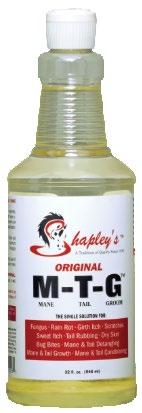




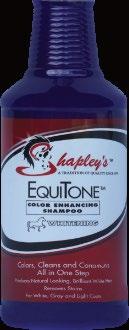







By Jessica Drexler, PAS, for Triple Crown Nutrition, the Official Feed Sponsor of USPC
You want the best for your horse, so you make sure to provide the very best care and feed. You carefully select a quality feed to ensure he is getting the best ingredients and all the nutrients he needs to be happy and healthy. In addition, it’s important that the feed you purchase is fresh, and is stored properly so that it stays that way. These seven tips will help ensure your horse feed stays fresh longer.
1. Check the date code on the feed bags. Triple Crown and many other feed companies typically have the manufacture date stamped on the bottom white tear strip or on the sewn-on tag using a series of letters and/or numbers. Many use the Julian date code system, which uses a combination of the year and the day within the year. January 1 would be 001 and December 31 would be 365. The year may be displayed with one or two digits (e.g., 5 or 25 for 2025). Manufacturing mills often use a letter code to designate where they were manufactured, like HAR for Harrisburg. Get familiar with how to read these date codes (e.g., a feed made at Harrisburg on April 30, 2025, is 25120HAR). Conversion charts are available online.
2. To buy or not to buy?
There are general guidelines (www.thehorse.com/17297/horsehay) for how long feed is considered fresh, but weather, storage, and usage all factor in. In the guidelines, equine nutritionist Clair Thunes, PhD, recommends using textured feed within 90 days of the manufacture date and pelleted feed within 180 days.
Ideally, lower-fat pelleted feeds should be fed within four to five months of manufacture date. For higher-fat feeds, feed within three to four months or less. The reduced “use-by” date is due to higher-fat feeds being more prone to mold.
While these are general guidelines, some owners may prefer feed that is fresher than three months old, while others may be fine with slightly older feed. It is documented that at about six months of age, vitamin and mineral levels in feed begin to break down, so this may be the maximum use-by date others follow as well.
Triple Crown provides this guideline:
“For freshness and palatability, it is recommended stores sell Triple Crown feeds within three to four months from date of production. Under proper storage conditions, feed quality can be guaranteed up to six months from date of production. Do not feed if product is moldy or has insect contamination.”
3. Buy smaller quantities versus stocking up, when possible. Feed will have a longer shelf life in cooler temperatures compared to hot, humid temperatures. We recommend only purchasing about two to three weeks’ worth of feed in hot temperatures and heading to the store when you are getting low. Buying larger quantities is just not worth the possibility of molding or spoilage if you are not able to use it within a reasonable time. However, you can usually stock up in cooler months. Carefully assess how much feed you need for each horse, which type of feed, and how many bags of each feed type you will need.
4. See something wrong with a feed bag at the store?
Say something!
If you are at the feed store and see feed that has old date codes, signs of bugs, or a bag that looks damaged, alert staff. Stores do their best to provide the freshest feed by:
■ Rotating feed—the first in should be the first out;
■ Storing feed in a clean and orderly location, away from weather and off the ground (usually on pallets); and
■ Making sure the feed area is free of insects and rodents and away from non-consumables, because feed can pick up the odor of chemicals or paint, for example, and then become unpalatable to horses.
One important reminder is to keep receipts for any feed and hold on to your empty feed bags, especially if you put your feed in bins or containers. Information on the bag is crucial should you have a product question or concern.
5. Store feed properly.
Follow the previous recommendations and store your feed in a cool, dry location away from weather, direct sunlight, and off the ground, and do your best to prevent insect and rodent infestation. You may choose to feed out of the bag, put the open bag in a bin and feed out of that, or pour feed directly into cans or bins. It’s important to ensure that feed stays sealed up against the elements and pests, so bins are a popular choice. Bins should be of a material that rodents can’t chew through, and the lid should be secure from the prying paws of a clever raccoon. You’ll also want to ensure your horse can’t get access to feed if he should he get loose,

especially due to the risk of laminitis that can result from binging a large meal.
Be sure that you completely use up feed in the bin and give it a good cleaning before adding new feed into the container. You do not want to pour new bags of feed on top of feed in the bin or it could eventually mold and develop insect issues. In addition to keeping the bin clean, it’s important for pest prevention to sweep up any feed that falls on the ground.
6. Inspect your new feed bags.
As you open new bags, inspect the feed for any signs of issues, such as mold, an off odor, bugs, or any contamination. If something isn’t right, do not feed it to your horse. If you recently purchased the bag and have the receipt and bag with the date code, follow the return guidelines for your store for either a return or refund. Keep in mind that if you stored feed for many months and then start to find moldy feed
Proper storage of supplements is just as important as your feed storage. Here are some tips to help you keep your products safe and secure.
1. Purchase supplements in smaller quantities. Supplements can lose potency over time, especially if exposed to heat, moisture, or air. Buying smaller amounts more frequently helps maintain freshness and effectiveness, reducing the risk of wasted products.
2. Store supplements in a cool, dry place. Heat, humidity, and sunlight can degrade vitamins and minerals in supplements. Keep them in airtight containers stored in a cool, dry, and dark location—such as a dedicated feed room or cupboard—to preserve their quality.
3. Label and date each supplement container. Keep track of purchase dates and expiration dates by clearly labeling containers. This helps you use older supplements first and avoid giving your horse expired products that may no longer be effective or safe. In addition, keep receipts in case there are any questions or concerns.
4. Avoid cross-contamination. Use clean, dedicated scoops or measuring tools for each supplement to prevent contamination. Never mix different supplements together unless directed by your veterinarian or nutritionist, as this can affect stability and dosage accuracy.
Follow these guidelines to ensure your supplements remain safe, potent, and beneficial. —Sarah Evers Conrad, USPC Marketing and Communications Director
bags, it is no longer the store’s (or the feed manufacturer’s) responsibility.
7. Check your feed daily.
Unfortunately, since feed is perishable, mold could happen at any time despite your best efforts, so check at each feeding. If you follow these tips, you can help ensure the feed you provide your horse is fresh and at an ideal age. This will also maximize the nutrients you are feeding your horse.
Need more help with your horse’s nutrition? Contact a Triple Crown Feed expert at www.triplecrownfeed.com or call 800451-9916 for personalized advice.

Brought to you by:

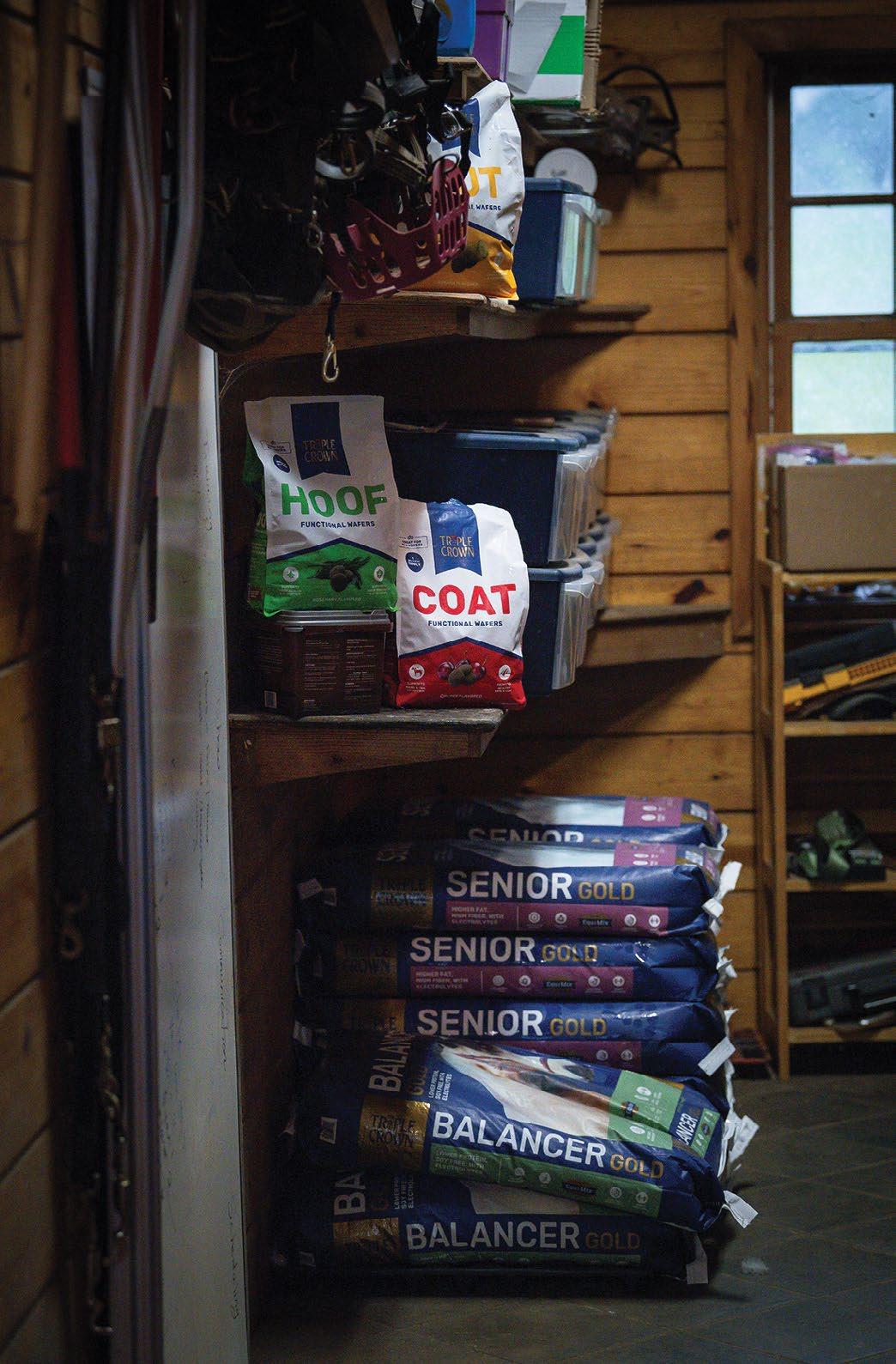

FACEBOOK: /USPonyClubs
INSTAGRAM: @UnitedStatesPonyClubs
YOUTUBE: /UnitedStatesPonyClubs
TIK TOK: @UnitedStatesPonyClubs
PINTEREST: /USPonyClubs
LINKEDIN: /company/ponyclub



Chloe Luedtke of St. Margarets Pony Club in the Maryland Region aboard Insuspence (aka, Stanley).


To be included, email a high-resolution image to marketing@ponyclub.org with name, Pony Club or Pony Club Riding Center, and name of the horse.




KERRITS IS A PROUD SPONSOR OF THE UNITED STATES PONY CLUBS






